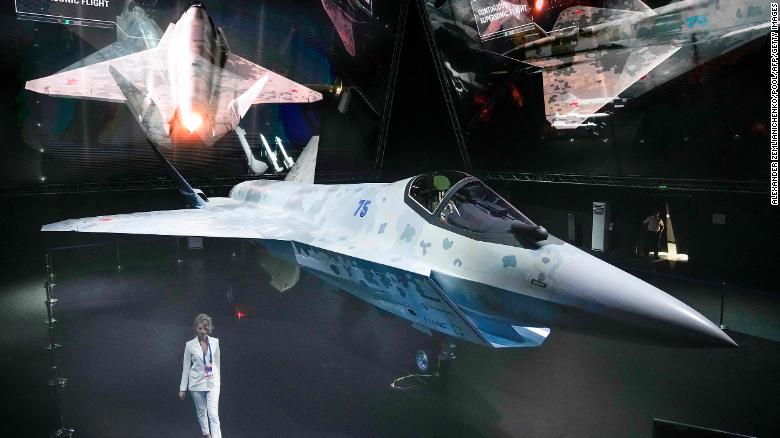

The wings are of relatively small-area delta shape.

The fighter is to be equipped with a modern engine with a deflected thrust vector, has a shortened take-off and landing distance, and can instantly react to a changing combat situation. The engine exhaust at the rear of the fuselage is circular, with thrust vector control features. The rather small ventral diverterless supersonic inlet (DSI) allows clean air intake to the turbofan within the middle-aft of the fuselage (the Lockheed F-16 "Fighting Falcon" and Eurofighter "Typhoon" multirole types both feature this design), as did the Boeing X-32 prototype strike fighter which unsuccessfully competed with the F-35 Lighting II design. This means that this aircraft can be used to gain air control and target enemy ground targets. The display near this aircraft said that the R-73 anti-air missile, R-77 anti-air missile and KH-59MK anti-ship cruise missile will be installed in the Checkmate fighter jet. The fuselage is deep, tapered at the nose and tail, housing small lateral weapons bays for single SRAAMs and a single larger ventral weapons bay with 3 MRAAMs. This engine is made on the basis of the groundwork of the United Engine Corporation, and will be even more advanced on this aircraft," said Alexey Bulatov, Deputy Chief Designer of Checkmate, during the presentation of the machine. "The engine will be in the 14.5-16 t class. The vehicle will be equipped with a highly efficient power plant. The fighter will be able to simultaneously hit up to six targets. The payload weight will exceed more than seven tons.
SUKHOI CHECKMATE FULL
It can be equipped with a full range of weapons of the range of aviation weapons, which is equipped with the fifth generation Su-57 fighter. Its speed will be Mach 1.8 and the combat radius is 3,000 km. The aircraft can be equipped with five air-to-air missiles. During the MAKS2021 presentation, a number of characteristics of the newest machine were announced. The Sukhoi Checkmate LTS is a single-seat, single-engine configuration with a the cockpit a short nosecone, presumably shrouding an AESA radar unit.

Deliveries of operational Su-57s to the Russian Aerospace Force are now expected to properly begin next year.Sukhoi Su-75 Checkmate - LTS - Light Tactical Aircraft - Design But progress with the type has been slow and it has still not entered operational service with the Russian Aerospace Force (which ordered 76 in 2019). Sukhoi is also responsible for Russia’s other stealth fighter design, the Su-57, which was launched at MAKS 2011. Mass production was likely to commence by 2026, and he estimated that 300 of the type would be produced over 15 years. While Rostec, in its presentation, stated that the Checkmate was now ready for flight testing, UAC general director Yuri Slyusar separately told journalists that the aircraft would make its first flight in 2023. It would not be equipped with an internal gun but would be able to carry gun pods in its side weapons bays. This payload would be able to include a wide range of Russian air-to-air and air-to-ground weapons. The fighter would have thrust vectoring, its airframe would be built to take a maximum stress load of 8 G (1 G is the force of gravity at sea level on Earth) and it would have a maximum payload of 7 800 kg. Rostec further stated that the Checkmate would have a maximum speed of Mach 1.8 (Mach 1 is the speed of sound) and a maximum range, on internal fuel, of 2 800 km. Pilot tasks would be automated through an onboard artificial intelligence, which would also monitor the onboard equipment diagnostics systems.

It would not need any specialised support equipment and would require only “minimum” ground crew. In the launch presentation last week, Rostec stated that the aircraft would come with an automatic integrated logistics system called Matreshka.


 0 kommentar(er)
0 kommentar(er)
